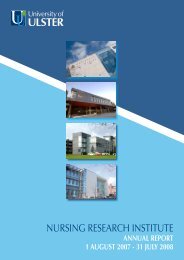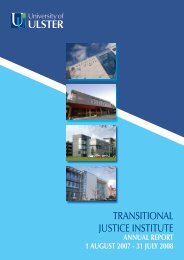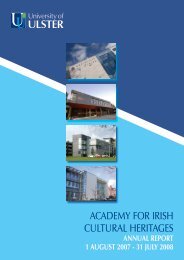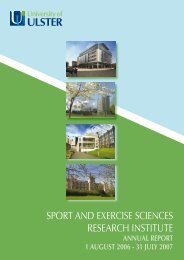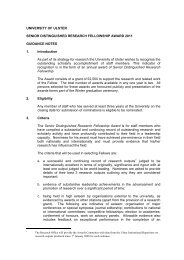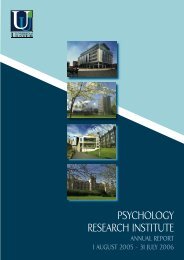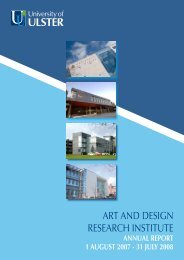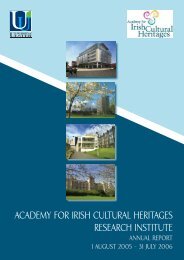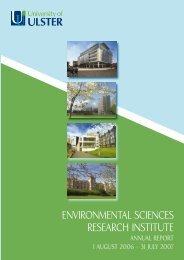academy for irish cultural heritages - Research - University of Ulster
academy for irish cultural heritages - Research - University of Ulster
academy for irish cultural heritages - Research - University of Ulster
You also want an ePaper? Increase the reach of your titles
YUMPU automatically turns print PDFs into web optimized ePapers that Google loves.
2. Foreword by the <strong>Research</strong> Institute<br />
Director 2004-2009<br />
<br />
<br />
Interdisciplinary research is the primary focus <strong>of</strong> the<br />
Academy <strong>for</strong> Irish Cultural Heritages (AICH), which<br />
was established with SPUR funding in December 2000.<br />
In setting up the Academy, the <strong>University</strong> <strong>of</strong> <strong>Ulster</strong> was<br />
making a key commitment to originality and innovation in<br />
scholarship and research in the field <strong>of</strong> <strong>cultural</strong> <strong>heritages</strong>,<br />
both Irish and international.<br />
But how is interdisciplinary research defined, and<br />
why is it so confusing Many established researchers<br />
find it difficult to cope with terms such as ‘inter-’ and<br />
‘multidisciplinarity’, but clearly they are not the same. A multidisciplinary project<br />
draws on several disciplines, but it does not radically re-define the theoretical<br />
canon <strong>of</strong> any single discipline. A multidisciplinary research team may involve<br />
researchers from several different disciplines. However, each researcher may<br />
continue to operate with rigour within his or her own disciplinary framework.<br />
In such circumstances, it is the combination <strong>of</strong> single-disciplinary skills and<br />
insights that generates a multidisciplinary outcome, but usually one can recognize<br />
distinctive disciplinary contributions in the end product.<br />
In contrast, an interdisciplinary project works across disciplines and breaks down<br />
traditional subject boundaries. An interdisciplinary assignment can, in theory,<br />
be completed by a single individual who works across different disciplines and<br />
combines methodologies in a radically new manner. The result, however, may be<br />
very difficult to attribute to any single-disciplinary framework. Interdisciplinary<br />
research may eventually generate new fields <strong>of</strong> research which cannot be easily<br />
classified within the current disciplinary framework.<br />
The difference between the two approaches was noted in the Academy report<br />
last year. I drew attention to a response in the post-RAE 1996 consultation<br />
process which pointed out that many projects described as interdisciplinary in the<br />
previous assessment would ‘more properly be termed “multidisciplinary”, since<br />
they bring together researchers from different subject disciplines on projects<br />
which essentially do not re-draw the subject map.’ That response identified<br />
other characteristics <strong>of</strong> interdisciplinarity: ‘where researchers work between and<br />
across disciplines, drawing innovatively on the subject matter and methodologies<br />
<strong>of</strong> more than one subject, or where a larger body <strong>of</strong> work which is similarly based<br />
has claims to be treated as a discrete emerging discipline in its own right’.<br />
Generally speaking, clearly defined disciplines have institutional status and<br />
privilege. They are easy <strong>for</strong> institutions to cope with. Interdisciplinary research<br />
is more difficult to characterize and support institutionally – although ultimately<br />
such research may generate entirely new and paradigm-shifting results. The Irish<br />
geographer Anne Buttimer, in her analysis <strong>of</strong> the life-cycles <strong>of</strong> various disciplines,<br />
once characterized the early stages <strong>of</strong> an emerging field <strong>of</strong> research as the<br />
Phoenix period ‘when new life emerges from the ashes with prospects <strong>for</strong> a<br />
fresh beginning’. This emancipatory movement can involve a cry <strong>for</strong> freedom from<br />
oppression or constitute an attempt ‘to soar to new heights <strong>of</strong> understanding,<br />
being and becoming’. It is usually followed by a ‘Faustian’ disciplining <strong>of</strong> the field<br />
in the process <strong>of</strong> gaining legitimacy in academic circles. Energies are directed<br />
towards ‘the building <strong>of</strong> structures, institutions and legal guarantees <strong>for</strong> their<br />
autonomous existence and identity.’ (Buttimer 1992: 43)



